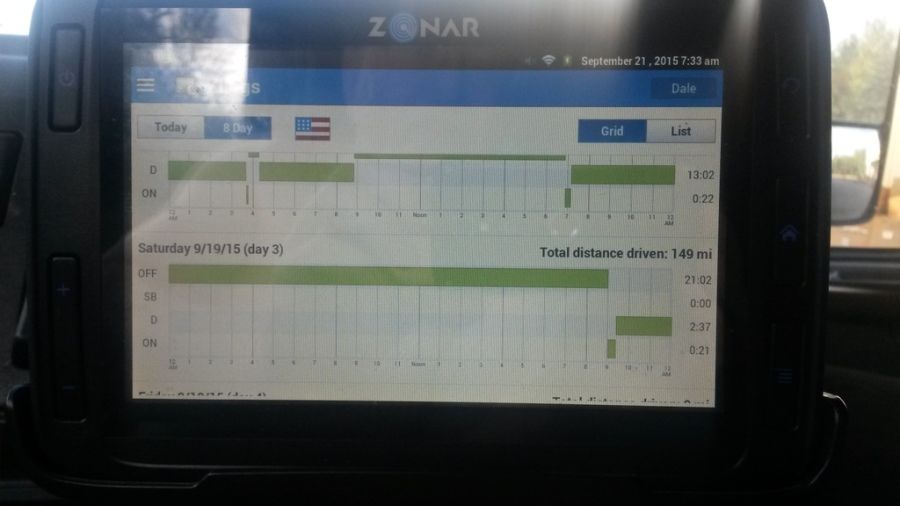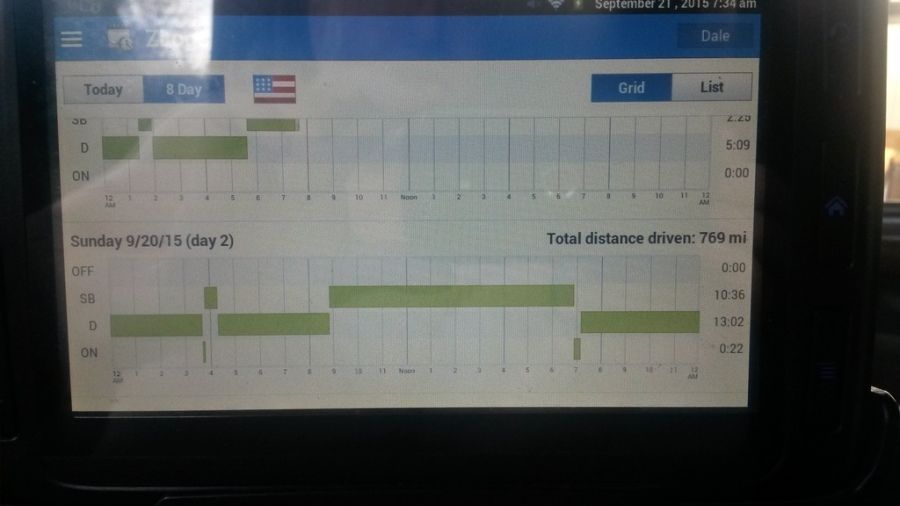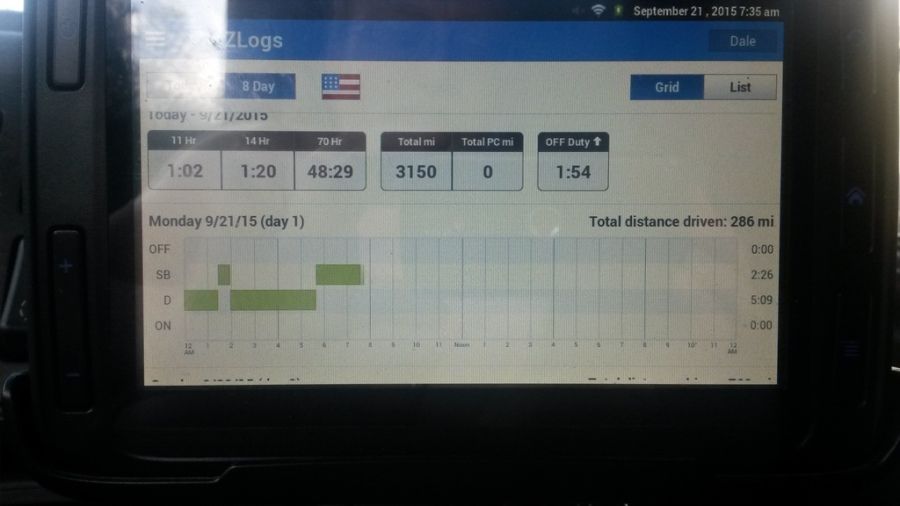How Can You Do That? A Puzzler For New And Future Drivers
Topic 10437 | Page 2

I was thinking his DM was being courteous. I'm guessing that once he starts his 70 driving at night he's kind of stuck there until a reset? Old School might prefer daylight driving and his DM may know that?
/shrug
Dm:
Dispatcher, Fleet Manager, Driver Manager
The primary person a driver communicates with at his/her company. A dispatcher can play many roles, depending on the company's structure. Dispatchers may assign freight, file requests for home time, relay messages between the driver and management, inform customer service of any delays, change appointment times, and report information to the load planners.Okay, you guys that were brave enough to participate did real good!
Let's address a few of the comments before I give the answer away. I did this as sort of an educational fun way to make you think about your hours and how to use them in an effective way.
After giving his answer,I-68 & I-79 boldly declares:
Now tell me I'm wrong
He was right on target until he made this faux pas:
(there's no 8 hour sleeper rule FYI)
Indeed there is a provision for only spending eight hours in the sleeper, and also for only spending two hours in the sleeper berth. I use it quite often, however it was not part of the answer to this puzzler. You can learn all about it by working your way through the logs section of the High Road Training Program.
Magoo got a little distracted with the split sleeper berth idea, but that is understandable since you would think I'm trying to trip you up with something like that. For the most part he was doing good. He makes this interesting observation:
I was thinking his DM was being courteous. I'm guessing that once he starts his 70 driving at night he's kind of stuck there until a reset? Old School might prefer daylight driving and his DM may know that?
I threw that part in about what my DM said because it illustrates how a lot of truck drivers think. I believe you have to free yourself from the status quo of normal thought processes to succeed at this stuff - you need to think outside the box - be creative with our solutions. Does anyone remember "Abe" the internet sensation of a truck driver who complained about his DM giving him a load that required him to drive all night after he had been up all day? I was in the same scenario here, only I took the measures necessary to make kit work by going ahead and making myself rest for several hours during the day so that I could be up for the challenge and ready to roll when called upon. I'll provide a link to that interesting discussion after I finish this up.
Magoo, I drive both night and day, often time switching back and forth from one to the other in just a matter of a few days. If you can learn to be versatile like that you will be able to accomplish more than most drivers, plus you will never be wondering why you are not getting sufficient miles. Here's an example: I drove two nights straight on this load just to make it happen. I got there at the receiver around 6:30 in the morning. I immediately put myself on the sleeper berth line and proceeded with a ten hour rest break. I'm good to roll again at 4:30 that afternoon. I have a six hour dead head to pick up my next load which picks up around ten a.m. next day. I get over there to my shipper at approximately 10:30 at night, start my next ten hour break and I'm good to start at 8:30 a.m. - that puts me back onto the day shift now for this next load which is what I need to make it work out most efficiently. Do you see how that works? I do this regularly, almost on a weekly basis. Flexibility, a willingness, and an ability to do stuff like this will help you tremendously - the reason it gives you an advantage over the other drivers on your DM's board is that you will be the "go to guy" - you will establish yourself as someone who "gits er done" no matter what. That is how you keep those strong consistent miles coming your way.
Michael was the star student because he recognized all the right questions to ask. I knew he was on the right track just by his questions. Those were things that you needed to know to give it a good shot.
Ultimately it was simple math that solved the equation, and you guys were pretty much all in agreement on that. There was so many hours to do the job, and you just needed to divide it up and decide how to attack the problem. You all did real well!
Here's the way I did it. I picked up my pre-loaded trailer, and got everything ready to go before I ever started my clock. Then I logged my fifteen minute pre-trip and started rolling for a long night of driving. Here's a screen shot of my logs for that first leg of the journey.

I apologize, it is a little hard to read but you can see I started my clock at 9:00 p.m. Then I did a pre-trip before I logged 149 miles by midnight.
The next day is the one where I managed to do 769 miles in one day with a truck governed at 62. The trick to doing that is to take your ten hour break in the middle of the day - that little known strategy leaves you 14 hours of driving time in the day. It is legal to drive that fourteen hours because you are splitting it up with the necessary ten hour break.

Then I finished it all off on the next day by arriving there before they started showing up at 7:00 a.m. When they got there I had been on the sleeper berth line for an hour or more, and I had all my straps off the load and it was waiting for them to unload it. Once unloaded I pulled back to the back of their yard and slept like a baby.

CDL:
Commercial Driver's License (CDL)
A CDL is required to drive any of the following vehicles:
- Any combination of vehicles with a gross combined weight rating (GCWR) of 26,001 or more pounds, providing the gross vehicle weight rating (GVWR) of the vehicle being towed is in excess of 10,000 pounds.
- Any single vehicle with a GVWR of 26,001 or more pounds, or any such vehicle towing another not in excess of 10,000 pounds.
- Any vehicle, regardless of size, designed to transport 16 or more persons, including the driver.
- Any vehicle required by federal regulations to be placarded while transporting hazardous materials.
Shipper:
The customer who is shipping the freight. This is where the driver will pick up a load and then deliver it to the receiver or consignee.
Sleeper Berth:
The portion of the tractor behind the seats which acts as the "living space" for the driver. It generally contains a bed (or bunk beds), cabinets, lights, temperature control knobs, and 12 volt plugs for power.
Dm:
Dispatcher, Fleet Manager, Driver Manager
The primary person a driver communicates with at his/her company. A dispatcher can play many roles, depending on the company's structure. Dispatchers may assign freight, file requests for home time, relay messages between the driver and management, inform customer service of any delays, change appointment times, and report information to the load planners.HOS:
Hours Of Service
HOS refers to the logbook hours of service regulations.OWI:
Operating While Intoxicated
PSD:
Prime Student Driver
Prime Inc has a CDL training program and the first phase is referred to as PSD. You'll get your permit and then 10,000 miles of on the road instruction.
The following is from Prime's website:
Prime’s PSD begins with you obtaining your CDL permit. Then you’ll go on the road with a certified CDL instructor for no less than 75 hours of one-on-one behind the wheel training. After training, you’ll return to Prime’s corporate headquarters in Springfield, Missouri, for final CDL state testing and your CDL license.
Obtain CDL Permit / 4 Days
- Enter program, study and test for Missouri CDL permit.
- Start driving/training at Prime Training Center in Springfield, Missouri.
- Work toward 40,000 training dispatched miles (minimum) with food allowance while without CDL (Food allowance is paid back with future earnings).
On-the-Road Instruction / 10,000 Miles
- Train with experienced certified CDL instructor for 3-4 weeks in a real world environment.
- Get 75 hours of behind-the-wheel time with one-on-one student/instructor ratio.
- Earn 10,000 miles toward total 40,000 miles needed.
Just for grins and educational purposes here's a link to a discussion with the Infamous Super Trucker.

Thanks for this Old School.
I can read information and retain it, but I do so much better when I see it in practice. I learned something about the clock that makes complete sense, yet I wasn't looking at it correctly. I had always assumed once your 10 or 14 is over the other one immediately starts no matter what. I see now that is more the case after being on duty but not neccessarily the case when coming from off duty.
Thanks again.
I did not see this thread previously, thanks PackRat for bumping it.
I just want to support Old School in his claim that clock management can add $10,000 (or more) to our income. This job is more fun when better money is earned, and the thinking outside the box, making efficient, effective use of the infernal clock, and being ready for anything are what will get you there if your company has the miles.
It also helps greatly if shippers and receivers permit parking on site for breaks. In my reefer world, most of them do not. Then, the ability to figure out a way to hide nearby and roll in or out off duty becomes critical. Google Maps sat view is our friend then.
Also, a comment regarding the ability to work past 11/14/70 so long as we are not driving: This is accurate of course, but just make sure to realize that we still have to plan for our break to fit in AFTER we are off the clock. So if we are doing something that we must log after our 11/14/70, just know that we need to get it a 10 (or at least an 8 in some cases) before we can drive again. If we are tight on an appointment, we need to factor this in. For example, if we are figuring to park right at the 11 hour line and take a tight 10 before driving, we need to factor in the required post trip and pre trip time, as well as maybe a fuel stop and/or scale or whatever. Trainers have to factor in their on-duty time while the student is driving. I blew it a couple of days ago....had a new student that needed me to take over at one point. I drove for awhile thinking all was well, but then later when I added in the training time, I saw that I had inadvertently gone over my 14. I filed an explanation....soon I will find out whether I am in trouble or not. I promised not to do it again in my report, so hopefully no one will be too mad at me, and hopefully I will not get an inspection in the next few days....I am probably ok there, because I had a Level I a few months ago, and have the sticker on my windshield from that.
Recently one of our fairly new members posed a hypothetical situation concerning Hours of Service (HOS) rules. As the discussion developed it became obvious that many folks in the discussion didn't really understand what the limitations of the 14 hour and 70 hour rules were. You can still be "on duty" after you have reached both of those limitations, but many don't seem to understand that. You can't drive once you've reached those points, but you can still be on duty and working without violating any rules.
I want to put a plug in for all of you who are contemplating this career or those who are already budding young rookies in their very first truck - Please take the extra time to go through the logs section of the High Road Training Program - the time you spend in there will help you tremendously as you begin your new career. I mean really study it, and try to comprehend it. For me, that section alone meant almost an extra 10 grand on my rookie year salary - I'm serious - grasping the nuances of how I could control my own destiny because I understood how the rules worked, kept me from being a slave to the clock. I was it's master, and my dispatcher was constantly amazed at how much I could accomplish.
The dispatcher I work with now still compliments me all the time on my clock management, and has several times asked me if I could teach a class some day for the other guys in our fleet. I tip my hat to Brett for that section of the High Road, it was like a revelation to me once I laid hold of the concepts in there.
Now here's a little quiz for your entertainment and hopefully for your education as well. Saturday of this week I was given a 1200 mile load that had to be delivered first thing (0700) Monday morning. That doesn't sound so bad until you find out they don't have the load ready until 2100 (9:00 PM Saturday night). My dispatcher was apologizing profusely to me and saying that the SAPA plant was having a log jam in the shipping department. He said "I know it can't be done, but just do the best you can and I will call the customer and let them know that it is not your fault." My response was "there's no need for you to call them and make us look bad, I'll be there Monday morning before they have even gotten to work." He exclaimed "it can't be done - your truck is governed at 62, and you really only have one day to drive (Sunday) - I don't want you to do anything illegal just to help us save face."
I did get there Monday morning before they started showing up, and on top of that I drove 769 miles on Sunday (legally in my governed truck).
Can you see the path to making a load like this happen on time? Please jump in here with your solutions - it's not to put any one on the spot, it's going to be a fun and educational guessing game. This is for the newbies, the rookies, and the wanna be's - give it your best shot!
Experienced drivers, please let the new guys and gals take a stab at this one - I'll provide the solution in a few days with some pictures of my electronic log screens to show you how to work this kind of magic.
CDL:
Commercial Driver's License (CDL)
A CDL is required to drive any of the following vehicles:
- Any combination of vehicles with a gross combined weight rating (GCWR) of 26,001 or more pounds, providing the gross vehicle weight rating (GVWR) of the vehicle being towed is in excess of 10,000 pounds.
- Any single vehicle with a GVWR of 26,001 or more pounds, or any such vehicle towing another not in excess of 10,000 pounds.
- Any vehicle, regardless of size, designed to transport 16 or more persons, including the driver.
- Any vehicle required by federal regulations to be placarded while transporting hazardous materials.
Shipper:
The customer who is shipping the freight. This is where the driver will pick up a load and then deliver it to the receiver or consignee.
SAP:
Substance Abuse Professional
The Substance Abuse Professional (SAP) is a person who evaluates employees who have violated a DOT drug and alcohol program regulation and makes recommendations concerning education, treatment, follow-up testing, and aftercare.
Dispatcher:
Dispatcher, Fleet Manager, Driver Manager
The primary person a driver communicates with at his/her company. A dispatcher can play many roles, depending on the company's structure. Dispatchers may assign freight, file requests for home time, relay messages between the driver and management, inform customer service of any delays, change appointment times, and report information to the load planners.Reefer:
A refrigerated trailer.
HOS:
Hours Of Service
HOS refers to the logbook hours of service regulations.OWI:
Operating While Intoxicated
Call me ignorant, but I thought we weren't able to log On Duty Not Driving past our 70 without getting an HOS violation. Since the 70h clock ticks when on either line 3 or 4, it makes sense to me that we're unable to log line 4 if we're out of 70 hours. Please correct me if I'm wrong.
HOS:
Hours Of Service
HOS refers to the logbook hours of service regulations.
Call me ignorant, but I thought we weren't able to log On Duty Not Driving past our 70 without getting an HOS violation. Since the 70h clock ticks when on either line 3 or 4, it makes sense to me that we're unable to log line 4 if we're out of 70 hours. Please correct me if I'm wrong.
Yes Sir, as requested, I will tell you that you are mistaken 
We can do anything we want to do past the 8/11/14/70 hour clocks, so long as it is not driving.
The government is not trying to control every aspect of our lives, just the portion that involves barrelling down the road in an 80,000 lb vehicle. (Or, even a lighter vehicle if it is being used commercially for various purposes.)
HOS:
Hours Of Service
HOS refers to the logbook hours of service regulations.When I first started driving I worried about the same thing. I contacted my manager and he verified the information dave gave, except my situation was the 30 minute break before the 8th hour. There are some times when I'm at a stop as I'm approaching my 8th hour and it ends up being my 8th and a half hour of my 14 by the time i take my 30 minutes. As long as you don't get switched over to driving past your legal hours you're good.
New Reply:
New! Check out our help videos for a better understanding of our forum features

















Preview:
This topic has the following tags:
Advice For New Truck Drivers Hours Of Service Logbook Questions Split Sleeper Berth Rule Trip Planning Truck Driving Lifestyle







 TT On Facebook
TT On Facebook
Well, there are thirty-four hours between 9PM Saturday and 7AM Monday. You have a full 70 to work with, subtracting a ten hour rest period from your hours available you have twenty-four on duty/driving hours available. If you drive as I-68 suggested, you should have no problem making it. Your dispatcher must have been thinking you'd only drive during daylight hours.
Given the length of your trip you might have crossed into a new time zone. Either picking up or losing an hour depending on the local times of shipper and receiver, but thirty-four hours is still a lot of time to work with give or take an hour.
Your dispatcher doesn't know you'll drive at night if need be?
Shipper:
The customer who is shipping the freight. This is where the driver will pick up a load and then deliver it to the receiver or consignee.
Dispatcher:
Dispatcher, Fleet Manager, Driver Manager
The primary person a driver communicates with at his/her company. A dispatcher can play many roles, depending on the company's structure. Dispatchers may assign freight, file requests for home time, relay messages between the driver and management, inform customer service of any delays, change appointment times, and report information to the load planners.